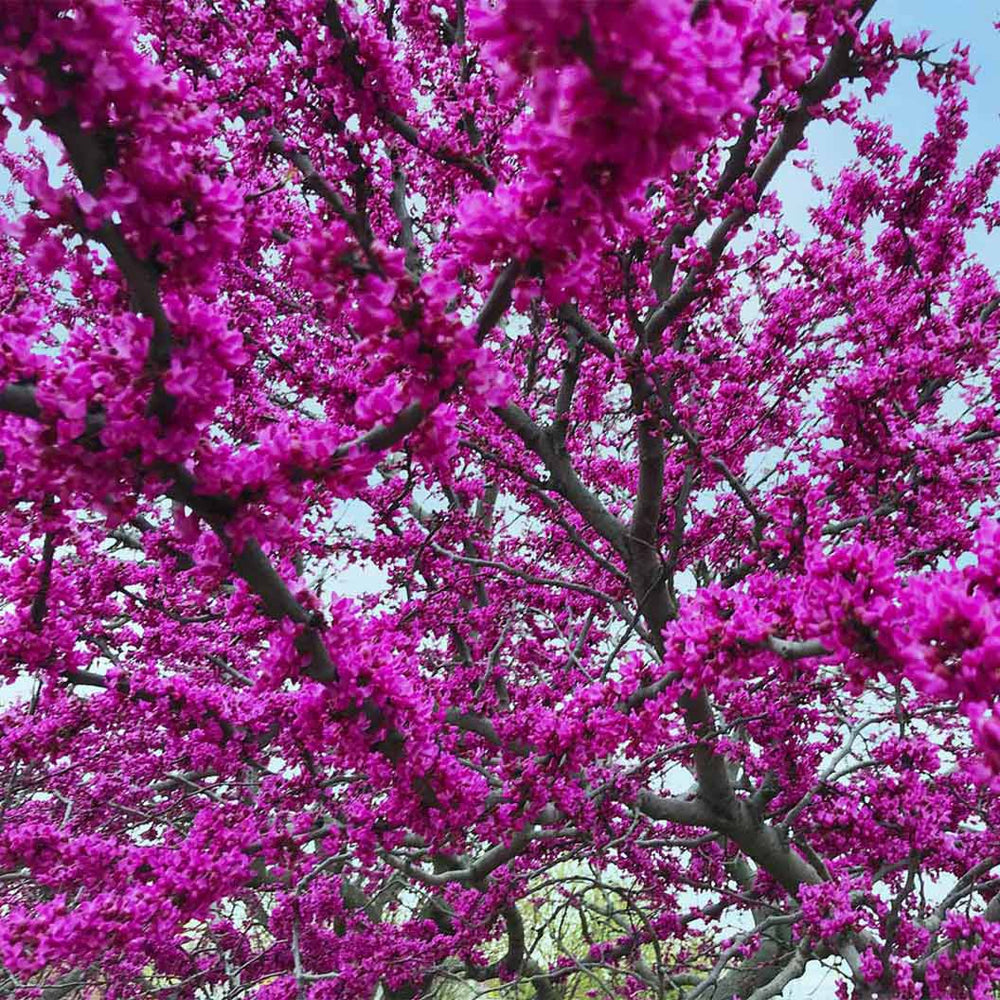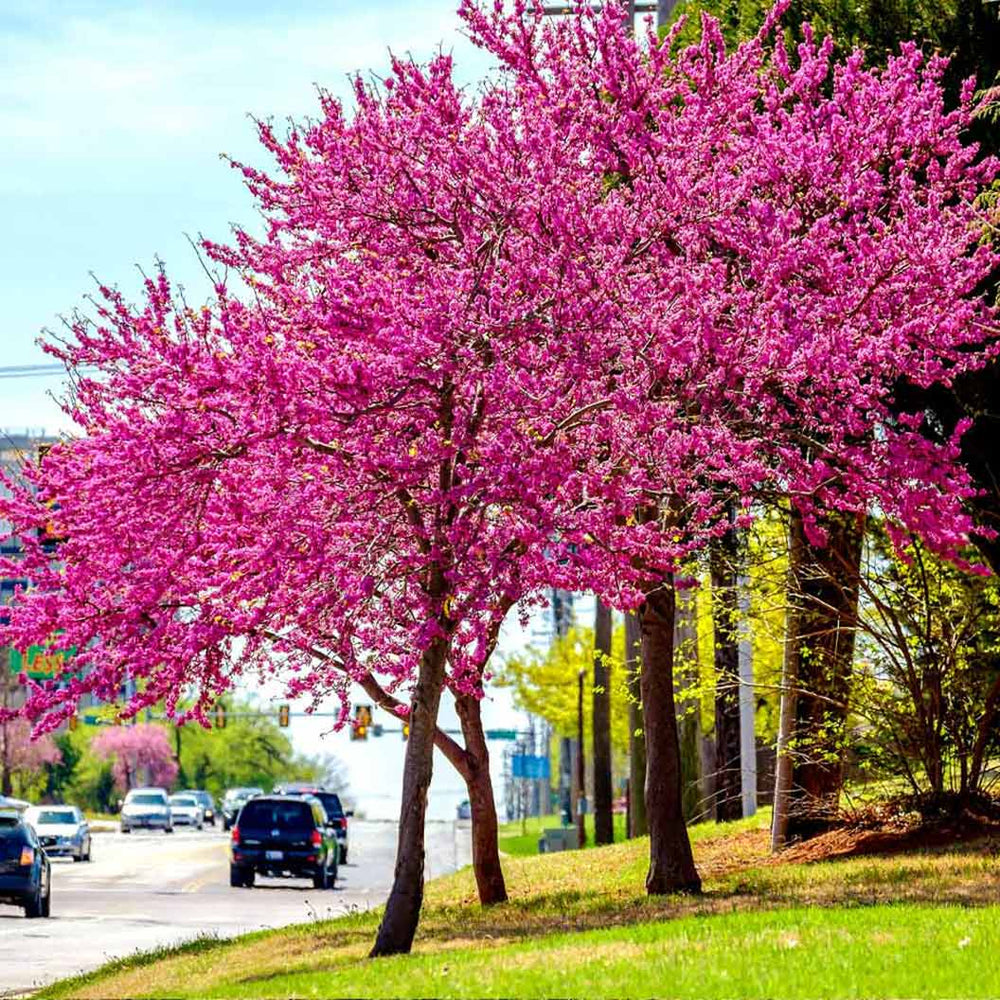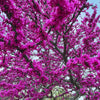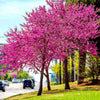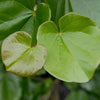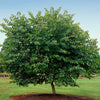* Images shown are of mature plants

Have questions? Talk with our Plant Experts (800) 973-8959
Save 25% on $200+ with code FALL25.
Questions? Call our plant experts: (800) 973-8959
Thousands of Blooms on One Tree
The Oklahoma Redbud is one of the first trees to flower in the early spring, blooming petite purple-red flowers in large clusters.
This blizzard of bright blooms appears in late winter or early spring. Soon after, dark green, glossy leaves (darker and richer than most other varieties) begin to form a beautiful backdrop.
Ideal for tight places or small lots, but will brighten up even the largest yards. Matures to a perfect 12-18 ft. tall, forming a dense, round shape. No other tree can offer this many blooms without taking up a ton of space.
Grows in a variety of soils and climates.
Oklahoma Redbuds are often used to accent gardens because they are very compact. However, they make great ornamental trees as well, being able to command attention with their showy purple-red flowers.
These are strong trees with deep root systems. Very resistant to storm, ice and wind damage.
Prefers Growing Zones 6-9.
Planting & Care
Choosing a location: The Redbud tree (or "Judas tree") is a lovely harbinger of spring and has been referred to as “a breath of fresh air after a long winter.” What makes the redbud so special is its gift of spring color and its hardy adaptability. The purple pink flowers of the eastern redbud appear all over the tree in early spring and are even produced on the larger trunks. They do well in locations with full sun to partial shade (afternoon shade is best). A soil pH of about 7.5 is recommended as well as well draining soil. Avoid planting in areas that are prone to flooding or that collect standing water.
Planting Directions:
1) Select a site 6 to 8 feet from existing structures and about 3 feet from fences. Clear a 4 to 5 foot radius of any competing plants, weeds or grass.
2) Redbud roots establish quicker in loosened, aerated soil so spread about 4 inches of compost over the planting site to improve drainage and the soil texture. After digging your planting hole blend compost into the soil to around 1 foot deep and 3 feet in diameter using a shovel and/or spade fork.
3) Dig a planting hole for the redbud twice as wide as the diameter and as deep as the depth of the root ball. Rub the root system to loosen the outer roots. Fill the hole halfway with the removed soil and top it off with water. Fill it in the rest of the way and water again to settle the soil, using a total of about 15 gallons of water.
4) Spread 3 to 4 inches of mulch over the planting site but be sure it's about 4 inches away from the base of the trunk to prevent fungus and rot. Mulch conserves water in the soil, adds nutrients as it breaks down and aids in weed prevention.
Watering: Watering a newly planted tree depends on things like the amount of rainfall you get in your area, temperatures and what season it is. When trees are newly planted their watering requirements are high but take care, root growth is slow in soil that is too wet or too dry. During the first year make sure to water your tree often enough to keep its soil moist yet not soaked. Pay close attention to your tree during the dry season, so that you can ensure that it receives enough water. Water later in the evening after the heat of the day has subsided. This way, the water will not evaporate immediately and the roots have a good chance at absorbing the moisture.
Pruning: To shape future growth, pruning redbud trees while they’re young is a must. Another reason to prune is to strengthen the connections of the main leaders to the trunk. Pruning helps form U-shaped junctions so the primary limbs can support leaves and flowers. Prune the tree in early summer after the tree is done blooming. Begin by removing any larger lower branches and branches that cross over each other or rub together. Cut off the branches close to the trunk without leaving any stubs. Stubs allow an entrance for disease and pests to enter. If several branches need to be removed, do it over a course of months so that the tree doesn't go into shock of losing so much of its growth. In late winter, prune any dead and diseased wood. Cut out any tiny twigs and branches that have turned brown. Also, cut off any shoots that are coming up from the bottom or out of the trunk.
*Tip: Sterilize your pruning tools with a basic household rubbing alcohol to ensure a healthy cut during pruning.
Fertilizing: In early spring you can apply some compost and/or a complete fertilizer such as 5-10-5 in *granular form. Spread evenly around the root zone of the plant according to the label instructions. This combined with maintaining several inches of organic mulch year round should be sufficient to feed the soil and keep the tree healthy.
*Granular (or dry fertilizer) is a type of fertilizer, which comes in a dry pelleted form as opposed to spikes, a liquid, or powder.
Early settlers found the blossoms of the redbud a delicious addition to their salads. Early folk healers used the bark to treat common maladies and sometimes even leukemia. Many Native Americans chose the wood of the California redbud for constructing their bows. The sheer springtime beauty of the redbud may be its greatest hold on the American spirit and a wonderful addition of color to any landscape.
Shipping Details
Estimated Shipping Time: Most orders ship immediately. As noted on the website, some items are seasonal, and may only ship in spring or fall. Once your order is shipped, you'll receive an email with a tracking number.
| Amount of Order | Shipping Charge |
|---|---|
| Less than $49 | $19.95 |
| $49 + | FREE SHIPPING! |
Product Details
| Mature Height: | 12-18 ft. |
| Mature Width: | 15-20 ft. |
| Sunlight: | Full-Partial |
| Growth Rate: | Moderate Growing |
| Botanical Name: | Cercis reniformis 'Oklahoma' |
| Does Not Ship To: | AK, AZ, HI, OR |
| Grows Well In Zones: | 6-9 outdoors |
| Your Growing Zone: | # |

